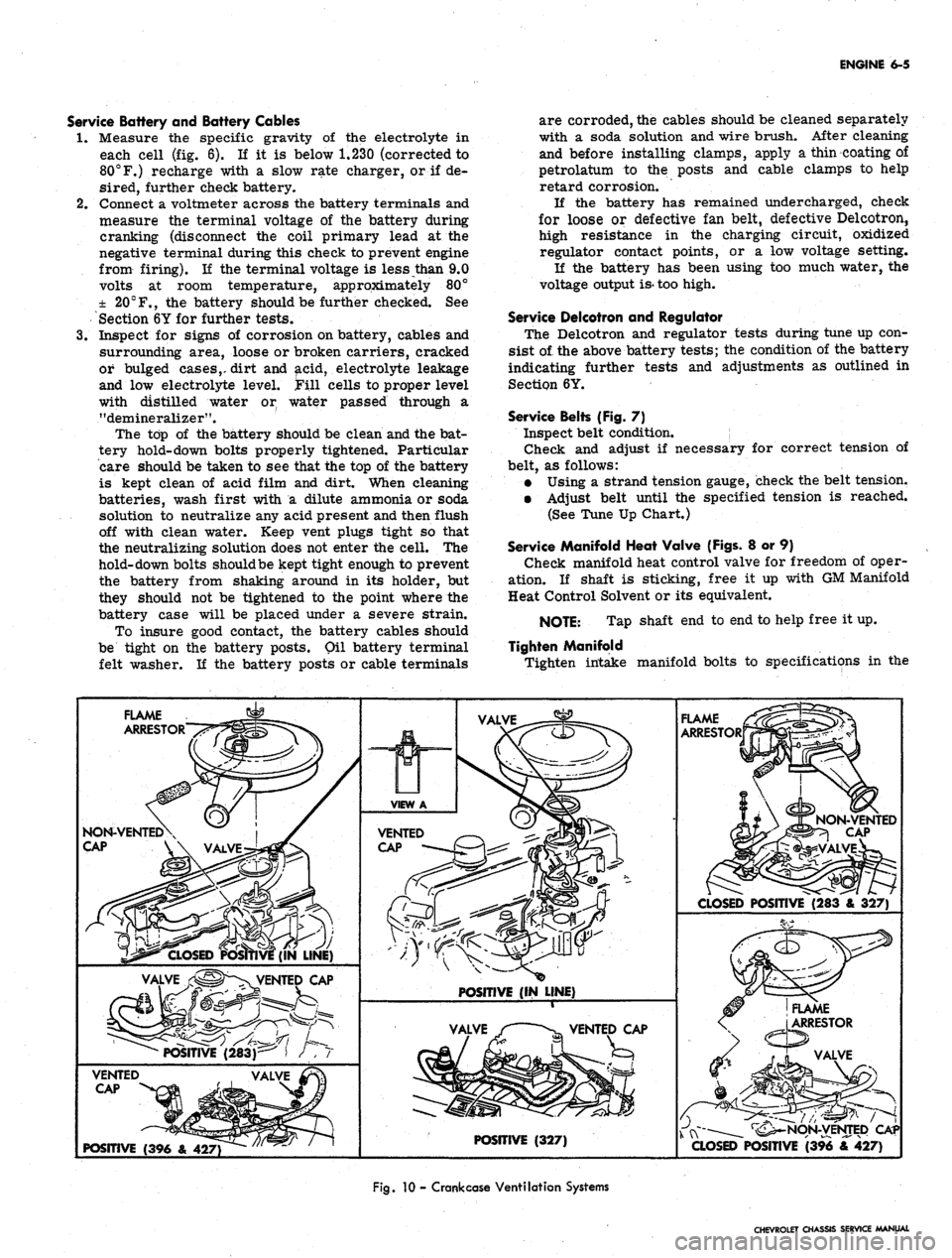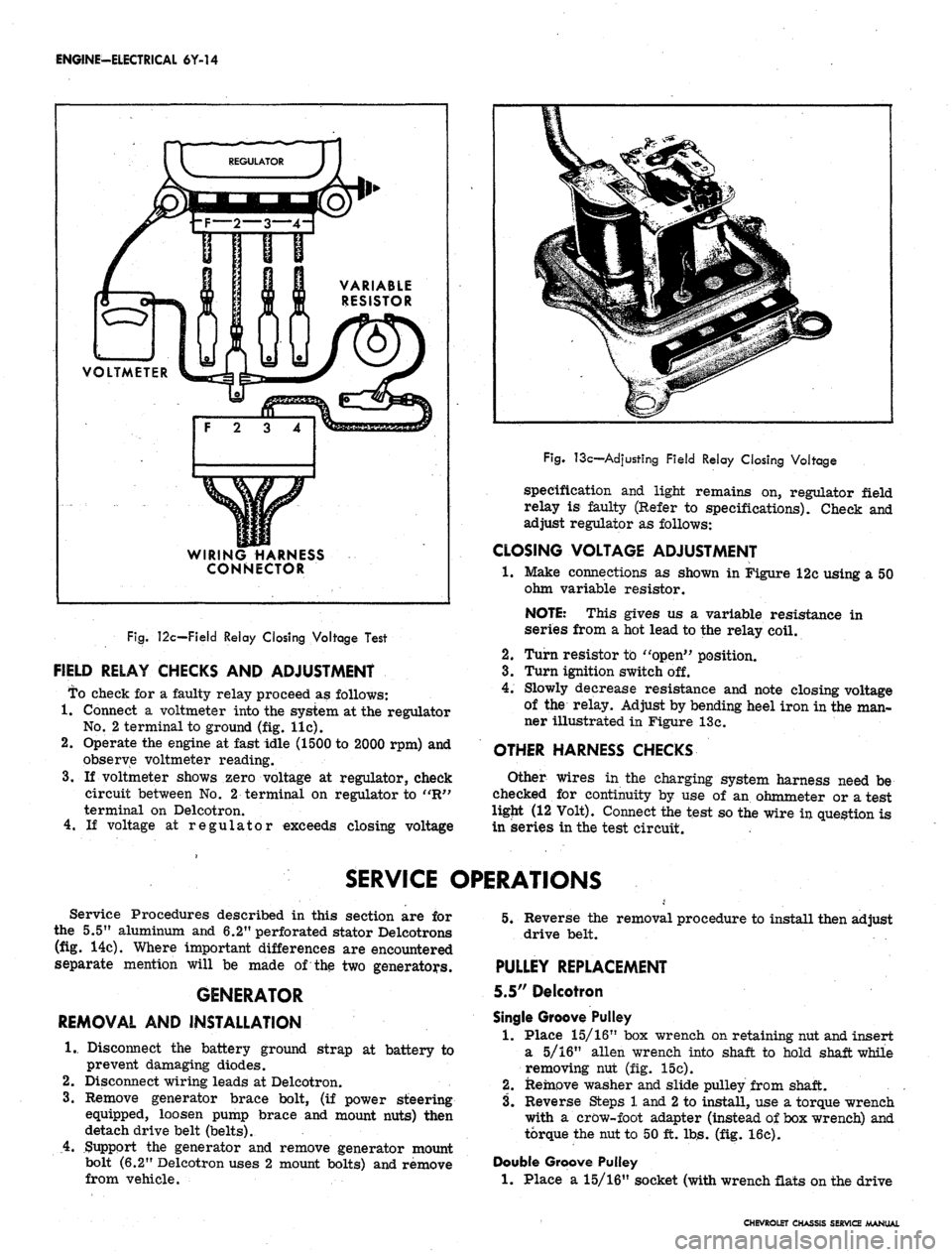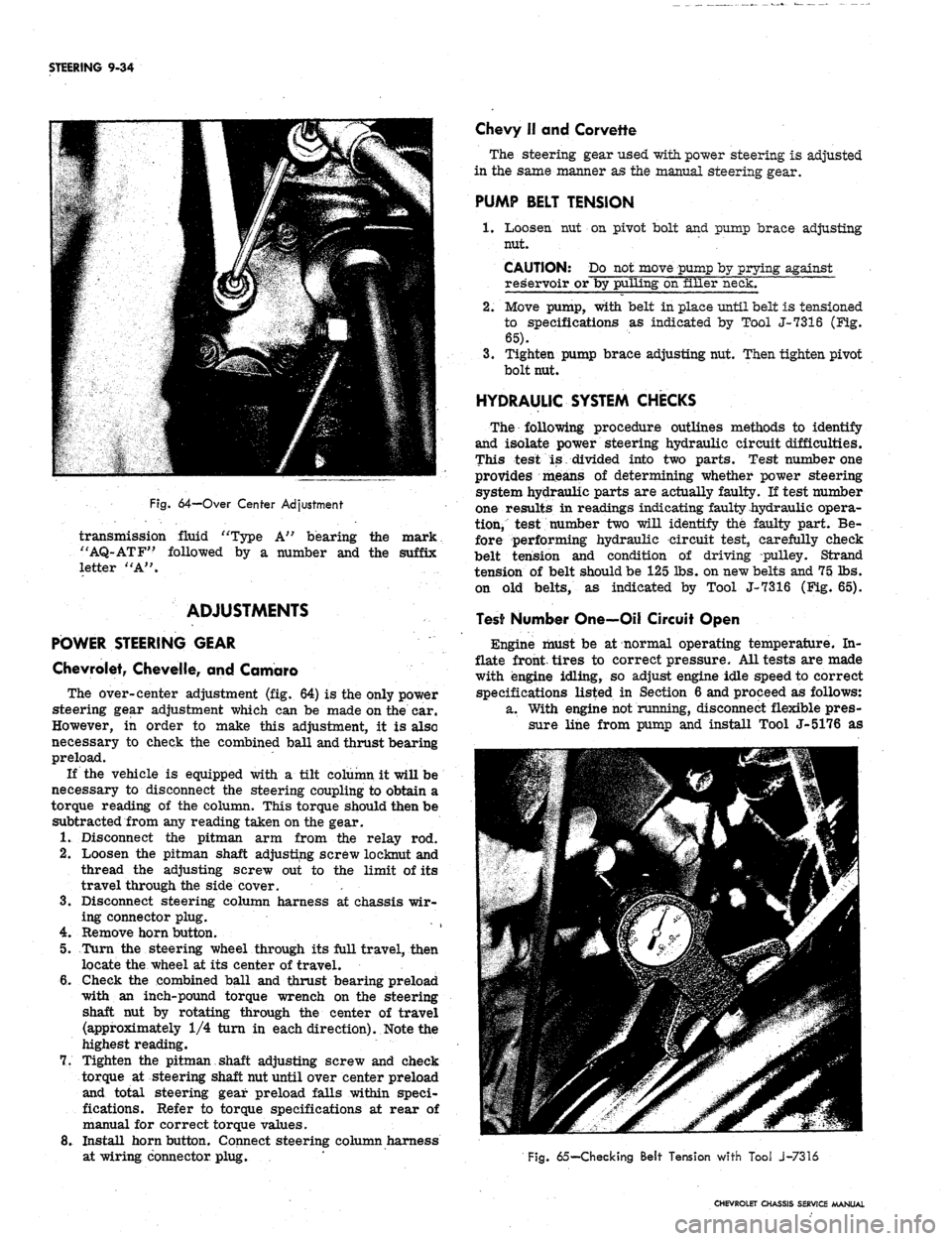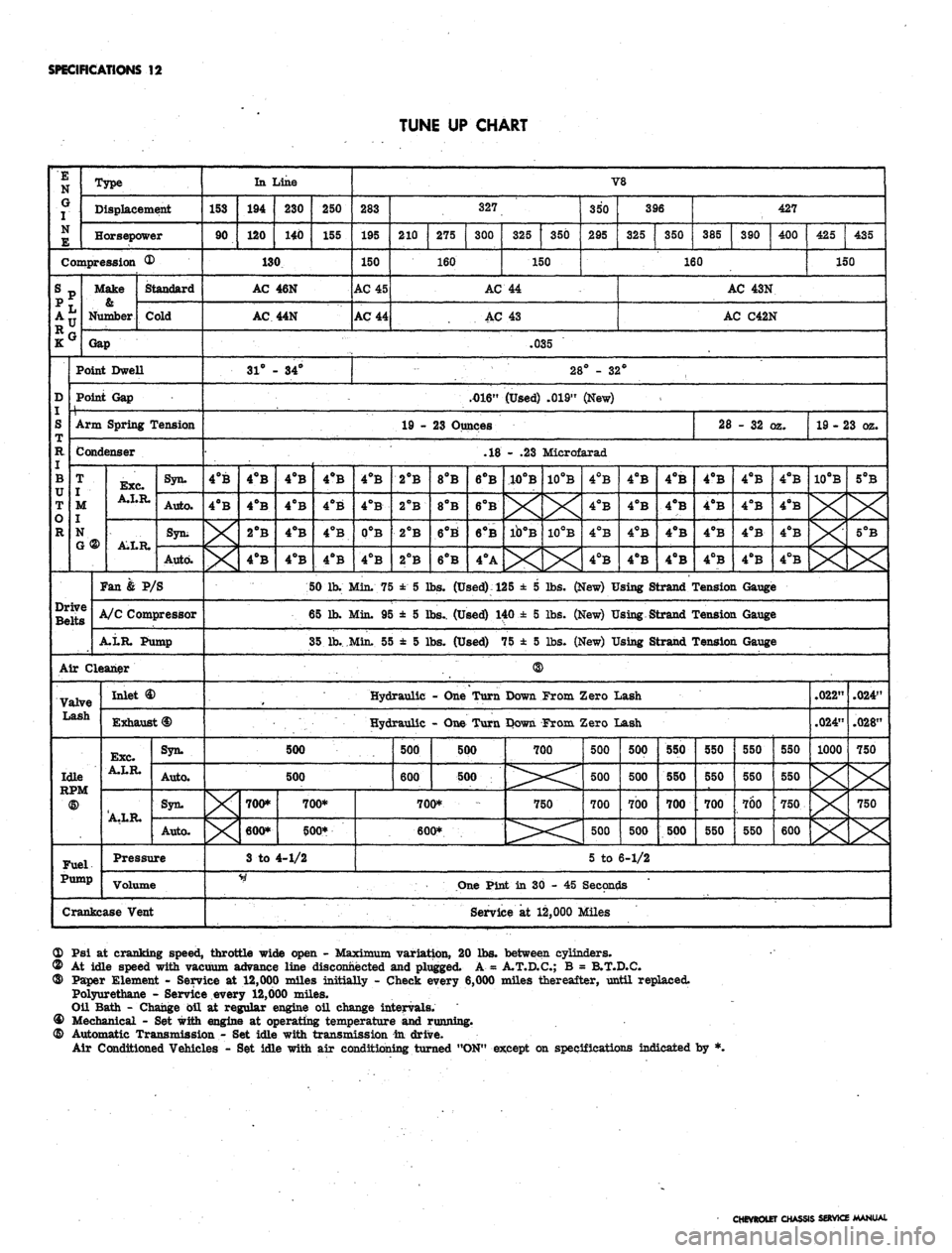Belts CHEVROLET CAMARO 1967 1.G Chassis Workshop Manual
[x] Cancel search | Manufacturer: CHEVROLET, Model Year: 1967, Model line: CAMARO, Model: CHEVROLET CAMARO 1967 1.GPages: 659, PDF Size: 114.24 MB
Page 260 of 659

BRAKES 5-27
CHEVELLE
, CHEVY II AND CAMARO SHOWN
1.
Caliper Belts
2.
Bleeder Valve
3. Caliper Half
4.
Piston Spring
Fig.
39-Caliper Assembly-Exploded View
5. Seal
6. Piston
7. Piston Boot
8. Brake Shoes
9. "O" Ri
10.
Caliper
11.
Retaining Pin
12.
Cotter Pin
caliper. Two retaining pins must be removed on
heavy duty Corvette front calipers. Identify the
inboard and outboard shoe if they are to be reused.
5. Remove the end of brake hose at bracket by re-
moving U-shaped retainer from the hose fitting and
withdrawing the hose from bracket.
6. Remove the caliper assembly from the mounting
bracket by removing two hex head bolts.
Disassembly (Fig. 39)
1.
Clean exterior of caliper with Declene, or equivalent.
On Chevrolet and Corvette front caliper, remove
brake hose.
2.
Separate the caliper halves by removing the two
large hex head bolts. Remove the two small "O"
rings from the cavities around the fluid transfer
holes in the two ends of the caliper halves.
3.
To free the piston boots so that the pistons may be
removed, push the piston down into the caliper
as far as it will go. Insert a screwdriver blade
under the inner edge of the steel ring in the boot,
and using the piston as a fulcrum, pry the boot from
its seat in the caliper
half.
CAUTION: Use care not to puncture seal when
removing pistons from caliper. ' ~
4.
Remove the pistons and piston springs from the
caliper
half.
Remove the boot and seal from their
grooves in the piston.
Cleaning and Inspection
1.
Clean all metal parts using Declene, or equivalent.
Remove all traces of dirt and grease. Do not use
mineral base solvents to clean brake parts.
2.
Using an air hose, blow out all fluid passages in the
caliper halves, making sure that there is no dirt
or foreign material blocking any of these passages.
3.
Discard all rubber parts. Boots, seals, and "O"
rings should be replaced with new service kit parts.
4.
Carefully inspect the piston bores in the caliper
halves. They must be free of scores and pits. A
scored or otherwise damaged bore will cause leaks
and unsatisfactory brake operation. Replace the
caliper half if either bore is damaged to the extent
that polishing with very fine crocus cloth will not
restore it.
CHEVROLET CHASSIS SERVICE MANUAL
Page 270 of 659

ENGINE
6-5
Service Battery and Battery Cables
1.
Measure the specific gravity of the electrolyte in
each cell (fig. 6). If it is below 1.230 (corrected to
80°F.) recharge with a slow rate charger, or if de-
sired, further check battery.
2.
Connect a voltmeter across the battery terminals and
measure the terminal voltage of the battery during
cranking (disconnect the coil primary lead at the
negative terminal during this check to prevent engine
from firing). If the terminal voltage is less than 9.0
volts at room temperature, approximately 80°
±
20°
F.,
the battery should be further checked. See
Section 6Y for further tests.
3.
Inspect for signs of corrosion on battery, cables and
surrounding area, loose or broken carriers, cracked
or bulged cases,- dirt and acid, electrolyte leakage
and low electrolyte level. !Fill cells to proper level
with distilled water or water passed through a
"demineralizer".
The top of the battery should be clean and the bat-
tery hold-down bolts properly tightened. Particular
care should be taken to see that the top of the battery
is kept clean of acid film and dirt. When cleaning
batteries, wash first with a dilute ammonia or soda
solution to neutralize any acid present and then flush
off with clean water. Keep vent plugs tight so that
the neutralizing solution does not enter the cell. The
hold-down bolts should be kept tight enough to prevent
the battery from shaking around in its holder, but
they should not be tightened to the point where the
battery case will be placed under a severe strain.
To insure good contact, the battery cables should
be tight on the battery posts. Oil battery terminal
felt washer. If the battery posts or cable terminals
are corroded, the cables should be cleaned separately
with a soda solution and wire brush. After cleaning
and before installing clamps, apply a thin coating of
petrolatum to the posts and cable clamps to help
retard corrosion.
If the battery has remained undercharged, check
for loose or defective fan belt, defective Delcotron,
high resistance in the charging circuit, oxidized
regulator contact points, or a low voltage setting.
If the battery has been using too much water, the
voltage output
is-
too high.
Service Deicotron and Regulator
The Delcotron and regulator tests during tune up con-
sist of the above battery tests; the condition of the battery
indicating further tests and adjustments as outlined in
Section 6Y.
Service Belts (Fig. 7)
Inspect belt condition.
Check and adjust if necessary for correct tension of
belt, as follows:
• Using a strand tension gauge, check the belt tension.
• Adjust belt until the specified tension is reached.
(See Tune Up Chart.)
Service Manifold Heat Valve (Figs. 8 or 9)
Check manifold heat control valve for freedom of oper-
ation. If shaft is sticking, free it up with GM Manifold
Heat Control Solvent or its equivalent.
NOTE: Tap shaft end to end to help free it up.
Tighten Manifold
Tighten intake manifold bolts to specifications in the
FLAME
ARRESTOR
FLAME
ARRESTOR
NON-VENTED\
CAP
V\ VALVE
CLOSED
POSITIVE (283 & 327)
POSITIVE
(IN LINE)
POSITIVE
(327)
POSITIVE
(396 & 427)
Fig.
10 -
Crank case
Ventilation Systems
CHEVROLET CHASSIS SERVICE MANUAL
Page 339 of 659

ENGINE-ELECTRICAL 6Y-14
VOLTMETER
WIRING HARNESS
CONNECTOR
Fig.
12c—Field Relay Closing Voltage Test
FIELD RELAY CHECKS AND ADJUSTMENT
To check for a faulty relay proceed as follows:
1.
Connect a voltmeter into the system at the regulator
No.
2 terminal to ground (fig. lie).
2.
Operate the engine at fast idle (1500 to 2000 rpm) and
observe voltmeter reading.
3.
If voltmeter shows zero voltage at regulator, check
circuit between No. 2 terminal on regulator to "R"
terminal on Delcotron.
4.
If voltage at regulator exceeds closing voltage
Fig.
13c—Adjusting Field Relay Closing Voltage
specification and light remains on, regulator field
relay is faulty (Refer to specifications). Check and
adjust regulator as follows:
CLOSING VOLTAGE ADJUSTMENT
•1.
Make connections as shown in Figure 12c using a 50
ohm variable resistor.
NOTE: This gives us a variable resistance in
series from a hot lead to the relay coil.
2.
Turn resistor to "open" position.
3.
Turn ignition switch off.
4.
Slowly decrease resistance and note closing voltage
of the relay. Adjust by bending heel iron in the man-
ner illustrated in Figure 13c.
OTHER HARNESS CHECKS
Other wires in the charging system harness need be
checked for continuity by use of an ohmmeter or a test
ligjit (12 Volt). Connect the test so the wire in question is
in series in the test circuit.
SERVICE OPERATIONS
Service Procedures described in this section are for
the 5.5" aluminum and 6.2" perforated stator Delcotrons
(fig. 14c). Where important differences are encountered
separate mention will be made of the two generators.
GENERATOR
REMOVAL AND INSTALLATION
1.
Disconnect the battery ground strap at battery to
prevent damaging diodes.
2.
Disconnect wiring leads at Delcotron.
3.
Remove generator brace bolt, (if power steering
equipped, loosen pump brace and mount nuts) then
detach drive belt (belts).
4.
Support the generator and remove generator mount
bolt (6.2" Delcotron uses 2 mount bolts) and remove
from vehicle.
5.
Reverse the removal procedure to install then adjust
drive belt.
PULLEY REPLACEMENT
5.5" Delcotron
Single Groove Pulley
1.
Place 15/16" box wrench on retaining nut and insert
a 5/16" alien wrench into shaft to hold shaft while
removing nut (fig. 15c).
2.
Remove washer and slide pulley from shaft.
3.
Reverse Steps 1 and
2
to install, use a torque wrench
with a crow-foot adapter (instead of box wrench) and
torque the nut to 50 ft. lbs. (fig. 16c).
Double Groove Pulley
1.
Place a 15/16" socket (with wrench flats on the drive
CHEVROLET CHASSIS SERVICE MANUAL
Page 474 of 659

STEERING 9-34
Fig.
64-Over Center Adjustment
transmission fluid "Type A" bearing the mark
"AQ-ATF" followed by a number and the suffix
letter "A".
ADJUSTMENTS
POWER STEERING GEAR
Chevrolet, Chevelle, and Camaro
The over-center adjustment (fig. 64) is the only power
steering gear adjustment which can be made on the car.
However, in order to make this adjustment, it is also
necessary to check the combined ball and thrust bearing
preload.
If the vehicle is equipped with a tilt column it will be
necessary to disconnect the steering coupling to obtain a
torque reading of the column. This torque should then be
subtracted from any reading taken on the gear.
1.
Disconnect the pitman arm from the relay rod.
2.
Loosen the pitman shaft adjusting screw loeknut and
thread the adjusting screw out to the limit of its
travel through the side cover. '. •
3.
Disconnect steering column harness at chassis wir-
ing connector plug.
4.
Remove horn button.
5.
Turn the steering wheel through its full travel, then
locate the wheel at its center of travel.
6. Gheck the combined ball and thrust bearing preload
with an inch-pound torque wrench on the steering
shaft nut by rotating through the center of travel
(approximately 1/4 turn in each direction). Note the
highest reading.
7.
Tighten the pitman shaft adjusting screw and check
torque at steering shaft nut until over center preload
and total steering gear preload falls within speci-
fications. Refer to torque specifications at rear of
manual for correct torque values.
8. Install horn button. Connect steering column harness
at wiring connector plug.
Chevy II and Corvette
The steering gear used with power steering is adjusted
in the same manner as the manual steering gear.
PUMP BELT TENSION
1.
Loosen nut on pivot bolt and pump brace adjusting
nut.
CAUTION: Do not move pump by prying against
reservoir or by pulling on filler neck.
2.
Move pump, with belt in place until belt is tensioned
to specifications as indicated by Tool J-7316 (Fig-.
65).
3.
Tighten pump brace adjusting nut. Then tighten pivot
bolt nut.
HYDRAULIC SYSTEM CHECKS
The following procedure outlines methods to identify
and isolate power steering hydraulic circuit difficulties.
This test is divided into two parts. Test number one
provides means of determining whether power steering
system hydraulic parts are actually faulty. If test number
one results in readings indicating faulty hydraulic opera-
tion, test number two will identify the faulty part. Be-
fore performing hydraulic circuit test, carefully check
belt tension and condition of driving pulley. Strand
tension of belt should be 125 lbs. on new belts and 75 lbs.
on old belts, as indicated by Tool J-7316 (Fig. 65).
Test Number One—Oil Circuit Open
Engine must be at normal operating temperature. In-
flate front, tires to correct pressure. All tests are made
with engine idling, so adjust engine idle speed to correct
specifications listed in Section 6 and proceed as follows:
a. With engine not running, disconnect flexible pres-
sure line from pump and install Tool J-5176 as
Fig.
65— Checking Belt Tension with Tool J-7316
CHEVROLET CHASSIS SERVICE MANUAL
Page 639 of 659

SPECIFICATIONS
12
TUNE UP CHART
E
N
G
I
N
E
Type
Displacement
Horsepower
Compression ®
srp
;•
D
S
R
I
B
TT
T
o
R
Make
0.
Number
Standard
Cold
Gap
Point Dwell
Point Gap
1 ,
Arm Spring Tension
Condenser
T
I
M
j
N
G ®
Drive
Belts
Exc.
A.I.R.
AXR.
Syn.
Auto.
Syn;
Auto.
Fan & P/S
A/C Compressor
A.LR. Pump
Air Cleaner
Valve
Lash
Idle
<§>
Fuel.
Pump
Inlet
Exhaust
<§)
Exc.
A.LR.
A.LR.
Syn.
Auto.
Syn.
Auto.
Pressure
Volume
Crankcase Vent
In Line
153
90
194
120
230
140
250
155
130
AC
AC
31° -
46N
44N
• 34°
V8
283
195
150
AC 45
AC 44
327
210
275
300
160
325
350
150
350
295
396
325
350
427
385
390
400
160
AC 44
AC 43
425
435
150
AC 43N
AC C42N
.035
28° - 32°
.4)16"
(Used) .019" (New)
<
19 - 23 Ounces
4°B
4°B
4°B
4°B
2°B
4°B
4°B
4°B
4°B
4°B
28
- 32 (
yz.
19 - 23 oz.
.18 - .23 Microfarad
4°B
4°B
4°B
4ftB
4°B
4°B
0°B
4°B
50 lb. Min. 75
65 Jh. Min. 95
35 lb..Min. 5£
500
2°B
2°B
2°B
2°B
8PB
8°B
6°B'
6°B
6°B
6°B
6°B
4°A
10°B
X
ib°B
X
10PB
X
10°B
X
4°B
4°B
4°B
4°B
4°B
4°B
4°B
4°B
4°B
4°B
4°B
4°B
± 5 lbs.
(Used):
125 ± 5 lbs. (New) Using Strand '
± 5 lbs.. (Used) 140 ± 5 lbs. (New) Using Strand '
>
± 5 lbs. (Used) 75 ± 5 lbs. (New) Using Strand r
Hydraulic - One Turn Down From Zero Lash
Hydraulic - One Turn Down From Zero Lash
500
X
700*
600*
3 to
700*
500*
4-1/2
500
600
500
500
700*
600*
700
750
500
500
700
500
500
500
700
500
550
550
700
500
4°B
4°B
4°B
4°B
4°B
4°B
4°B
4°B
4°B
4°B
4°B
4°B
Tension Gauge
Tension Gauge
Tension Gauge
550
550
700
550
550
550
700
550
550
550
750
600
10°B
5°B
X
X
.022"
.024"
1000
X
X
X
.024"
.028"
750
X
750
X
5 to 6-1/2
One Pint in 30 - 45 Seconds
Service at 12,000 Miles
OD Psi at cranking speed, throttle wide open - Maximum variation, 20 lbs. between cylinders.
© At idle speed with vacuum advance line disconnected and plugged. A = A.T.D.C.; B = B.T.D.C.
® Paper Element - Service at 12,000 miles initially - Check every 6,000 miles thereafter, until replaced.
Polyurethane - Service every 12,000 miles.
Oil Bath - Change oil at regular engine oil change intervals.
® Mechanical - Set with engine at operating temperature and running.
@ Automatic Transmission - Set idle with transmission in drive.
Air Conditioned Vehicles - Set idle with air conditioning turned "ON" except on specifications indicated by *.
CHEVROLET CHASSIS SERVICE MANUAL